Trees Birds Mammals Fish Amphibians Reptiles
Wild Algarve
Bookshop
Gymnopus peronatus (Bolton) Gray - Wood Woollyfoot
Phylum: Basidiomycota - Class: Agaricomycetes - Order: Agaricales - Family: Marasmiaceae
Distribution - Taxonomic History - Etymology - Identification - Culinary Notes - Reference Sources
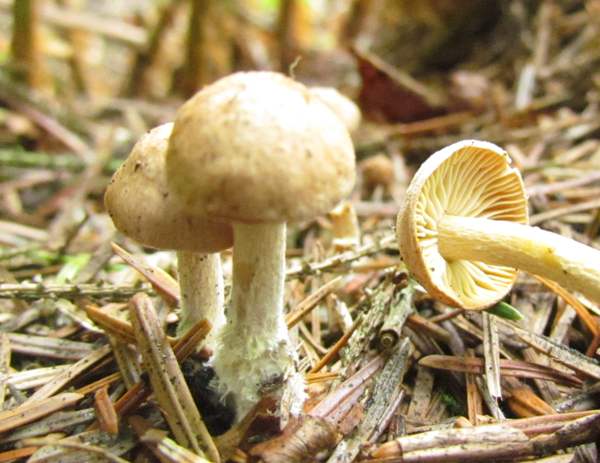
Gymnopus peronatus (syn. Collybia peronata) is commonly referred to as the Wood
Woollyfoot, on account of the lower half of the stem being covered in
fine white hairs. This widespread and common mushroom of leaf litter is poisonous; its cap colour is also very variable, which can make confident identification more difficult. Commonly known as the Wood Woollyfoot, this attractive little mushroom is
sometimes recorded under the synonymous scientific names Marasmius peronatus or Marasmius urens.
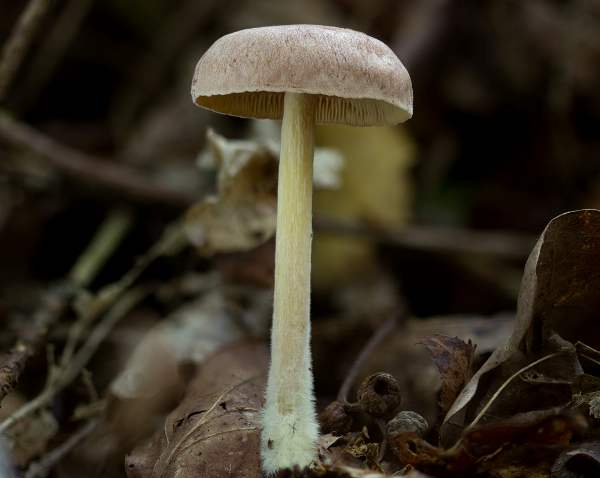
Distribution
This pretty little woodland mushroom is widespread and fairly common throughout Britain and Ireland as well as in all other European countries from Scandinavia to the Mediterranean. It occurs also in many regions of Asia as well as in some parts of North America.
Taxonomic history
British naturalist James Bolton created the basionym of this species when he described this species in 1788, calling it Agaricus peronatus. (Most gilled fungi were initially placed in a giant Agaricus genus, but the majority have since been redistributed to other genera leaving the 'true mushrooms' in Agaricus.) It was another British mycologist, Samuel Frederick Gray (1766 - 1828), who in 1821 transferred this species to the genus Gymnopus, thus establishing its currently-accepted scientific name Gymnopus peronatus.
Synonyms of Gymnopus peronatus include Agaricus peronatus Bolton, Agaricus urens Bull., Marasmius peronatus (Bolton) Fr., Marasmius urens (Bull.) Fr., Collybia peronata (Bolton) P. Kumm., and Collybia urens (Bull.) P. Kumm.
Etymology
Gymnopus, the generic name, comes from Gymn- meaning naked or bare, and -pus meaning foot (or, in the case of a mushroom, stem). The specific epithet peronatus comes from Latin and means sheated - a reference to the woolly-booted appearance of the stem base..
Identification guide
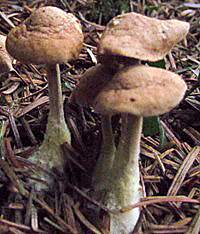 |
Cap
3 to 6cm in diameter, the convex caps expand
and flatten out at maturity, sometimes retaining a broad umbo. Cap colour is quite variable, ranging from pinkish-cream to yellowish-buff.
Old caps (left) often become shrunken and very wrinkled.
|
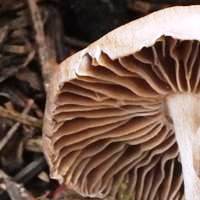 |
Gills
Unlike other members of the former Collybia genus, whose gills remain white or
pale cream, Gymnopus peronatus matures with red-brown gills - a useful
distinguishing characteristic.
The moderately spaced adnexed or almost free gills are pale at first, becoming
reddish-brown as the fruitbody matures. |
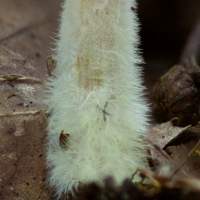 |
Stem
4 to 6mm in diameter and 4 to 8cm
tall, the lower half of the stems of this species are covered in small
pale hairs. |
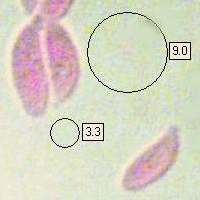 |
Spores
Elongated ellipsoidal, smooth, 8.5-10 x 3-4µm.
Spore print
White. |
Odour/taste |
Odour not distinctive; taste very peppery. |
Habitat & Ecological role |
Saprobic, in leaf litter beneath broadleaf trees and
hedgerows, and under bracken on heathland. |
Season |
July to October in Britain and Ireland. |
Similar species |
Laccaria laccata, the Deceiver, is similarly coloured but
does not have pale woolly hairs at the base of its stipe. |
Culinary Notes
The Wood Woollyfoot is an inedible species because of its very hot and peppery taste.
Reference Sources
Pat O'Reilly; Fascinated by Fungi, 2016.
Dictionary of the Fungi; Paul M. Kirk, Paul F. Cannon, David W. Minter and J. A. Stalpers; CABI, 2008
British Mycological Society (2010). English Names for Fungi
Taxonomic history and synonym information on these pages is drawn from many sources but in particular from the British Mycological Society's GB Checklist of Fungi.
Top of page...
Fascinated by Fungi. Back by popular demand, Pat O'Reilly's best-selling 450-page hardback book is available now. The latest second edition was republished with a sparkling new cover design in September 2022 by Coch-y-Bonddu Books. Full details and copies are available from the publisher's online bookshop...